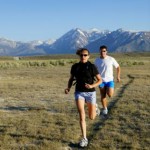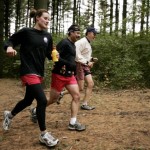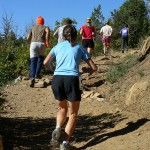Replay: Jesus is the Reason… for our lack of unity?
I originally wrote the post “Jesus is the Reason” to be published three years ago on Christmas Day, December 25, 2008. If you have been reading my blog for even a short time, I hope you have noticed that I am very concerned about the rampant divisiveness among the followers of Jesus Christ. There is a lack of unity among the church that is apparent not only to believers, but also (and perhaps even more so) to those who are not Christians.
Even something like Christmas – to celebrate or not to celebrate – is a cause of division. I hope this post helps us move toward unity in Christ – even if it’s only in a small way.
———————————-
Jesus is the Reason
So, it’s Christmas Day [or Christmas Eve in this “Replay”].
If you believe that this is the most holy day of the year, then I have a request of you. Please remember that Jesus is the reason for you to live every day – he’s not simply a slogan to tack on to your life on Christmas Day. Celebrate this day as unto the Lord. Also, remember your brothers and sisters who choose to view all days as equally holy. They also celebrate all days as unto the Lord.
If you believe that Christmas Day should not be celebrated as the most holy day of the year, then I have a request of you. Please remember that Jesus is the reason for you to live every day – including today. You do not have an excuse to be unkind or ungenerous simply because you do not choose to celebrate Christmas Day. Celebrate this day, as all days, unto the Lord. Also, remember your brothers and sisters who choose to view this day as special. They also celebrate this day as unto the Lord.
Even the hearts and minds of unbelievers are turned toward God and spiritual things during this time. Look for opportunities to speak of God’s grace and truth to those who need to hear.
Live today for the glory of God. Love him and love those around you. Serve the people that God brings across your path. Serve them before they can serve you. Accept those who are different. Be patient with those who are less mature. Follow those who are more mature. Walk in Spirit. When you come together with your brothers and sisters in Christ, seek to build them up, to stir up love and good works within them, and to mature them in Christ Jesus.
Have a Merry Christmas!
Did she just say Happy Holidays?
Merry Christmas! Feliz Navidad! Fröhliche Weihnachten! Joyeux Noël! Buon Natale! Feliz Natal! Mele Kalikimaka!
What!?!? Did she just say, “Happy Holidays”? That just won’t do…
Ok… so, just to be clear, I tell people, “Merry Christmas.” But, I’m not upset or offended when someone says, “Happy Holidays.” In fact, I do not assume that someone is a nonChristian if that person says, “Happy Holidays.”
What would happen if Christians actually talked with (and listened to) people talk about how THEY celebrated the “holidays” instead of responding in more negative ways?
I could imagine a conversation kinda like this…
—————————–
“Happy Holidays,” she said as she handed me the receipt.
“Thank you,” I said with a smile. The story was almost empty, and there was no one in line behind me, so I continued, “Which holiday or holidays are you celebrating?”
She seemed a little surprised, but I stopped and made sure she could tell that I was truly interested in what she would say.
“ummm… What do you mean?” she answered with a question, obviously a little unsure of my intent.
“Well, different people celebrate this time of year for different reasons: Thanksgiving, Hanukkah, Kwanzaa, Christmas, New Years. Some people just enjoy this time of year by taking a break from work or school and spending time with family. Others recognize the change of seasons or the winter solstice. What are you celebrating during the holidays?”
She stopped for a moment, and looked at me funny again. “You know, no one has ever asked me that before. My family got together for Thanksgiving, and we have several different Christmas traditions…” She told me about some of her family’s plans including travel and parties.
For some reason, I’m always surprised, but I know that people love to talk about things that they care about, especially to someone who is really listening. So, I listened, and made a couple of comments about corresponding traditions or places that I’d been before.
As she stopped talking about herself and her family, I thanked her for telling me about her holiday plans, and started to turn away out of the store.
“What about you?” she asked. “What are you doing for the holidays?”
I turned back toward her and smile. I don’t know if she was as interested in hearing my reasons to celebrate or not, but she had asked. So…
—————————–
The way I see it, this kind of encounter – any time of year – must be preceded by the following:
1) An earnest concern for the other person and a desire to hear what the other person has to say. (In other words, don’t ask the other person about her beliefs ONLY so that you can share your own.)
2) A willingness to walk away without sharing your own beliefs/plans/whatever if the person does not ask.
So, what about you? Have you ever had an interesting conversation with someone because you reacted in a way that showed you genuinely cared about them (especially when your response was different than what they may have expected from Christians)?
Replay: Christmas 1993 and Eternity
The first Christmas after I started this blog (Christmas 2006), I wrote a post called “Christmas ’93 and Eternity.” I re-posted it in 2007 and 2009, every 2 years. Since I’m not one to break with tradition (ahem), I thought I would post it again today.
But, there’s another reason to “replay” this post today. The post is about the birth of my son, Jeremy, in 1993. And, today, he turns 18. So, when you read the post below, remember these 2 things: 1) I wrote this post when Jeremy had just turned 13. And 2) we plan to celebrate by going to Red Robin so that Jeremy can order a Royal Red Robin hamburger. (Point #2 is not important in reading the post; but it is important if you know Jeremy.)
—————————————–
A few days ago, we celebrated my son’s 13th birthday by taking him to see the movie Eragon. He and his friends enjoyed it, though the story was a bit predictable for me.
Anyway, celebrating his birthday and preparing for Christmas reminded me of the Christmas of 1993. Our son was born on the 22nd of December that year. We brought him home on Christmas eve, stuffed in a red stocking. The next morning, we gave him his first Christmas gifts: clothes, a stuffed animal, and a full-size football (autographed by Bo Jackson, which is only important to half the population of the state of Alabama).
My wife was surprised that I would get my newborn son a football. But, he quickly outgrew both the clothes and the stuffed animal, but he can still play with the football! So, the football turned out to be a better gift than she thought at first. True, a three day old baby can do nothing with a football but drool on it. But, eventually, he grew to love football.
As I was thinking about his first Christmas and his first Christmas gifts, I wondered how often I focus on things that will truly last. I don’t even mean things that will last a few years or even a lifetime. But, how often do I focus on things that will last eternally? As I understand it, the only things on earth that are eternal are people. Do I give gifts that will make an eternal difference? Do I give things that will eventually fade? Or, do I give of myself to people who will last for eternity?
One day, I will join with multitudes around the throne of God. I hope that even this year I am giving eternal gifts.
p.s. Last year, we give our (then) 12 year old son a special gift. We asked several men who had impacted his life to write him a letter. We asked them to tell him something that they wished someone had told them when they turned 12. We then took all of the letters and bound them in an album. It turned out to be a very special gift!
Report on Simple/Organic/House/Missional Church in the UK and Ireland (2011)
Ben from “MissionBritain” wrote a guest post for me a few months ago called “Building a culture of discipleship.” (If you haven’t read his guest post, please do. It is excellent!)
Last week, he sent me a copy of a report on simple/organic/house/missional churches in the UK and Ireland. You can read more information and download the complete report here: “Simple/Organic/House/Misisonal Church in the UK and Ireland (2011).”
While I would encourage you to read the entire report, I want to highlight a few of the statistics. (By the way, the report is NOT a list of statistics. Instead, it includes much more information, including some suggested steps forward.)
We asked people to describe their simple/organic/house/missional church and the top answer was – “We are a group of Christians seeking to live out New Testament principles/models of church.”
We asked people to describe their journey so far in terms of seeing people baptised.
– Approximately 60% of people said that they had seen some people baptised and discipled.
– No-one said that they had seen many people baptised and discipled.
– 40% of people involved with simple/organic/house/missional church in the UK and Ireland said that “It has been a challenge to keep persevering on this path when it seems that we have seen little fruit from our efforts.”
Do you see the disconnect? While most of the people in the report said they were trying to “live out New Testament principles,” very few were actually baptizing or making disciples. In fact, a large number (40%) said they had seen “little fruit.”
Now, I’m sure these 40% have seen many changes when it comes to church practices, methods of gathering together, and leadership. But, they have seen “little fruit” specifically in terms of baptism and discipleship.
Should we expect “fruit” if we are living according to New Testament principles? If so, is there something missing? What?
Look at your feet; look at the path; look further ahead
When running on roads or sidewalks, I tend to spend most of the time looking ahead, either a few feet down the road or even further. If I’m about to cross from road to sidewalk or if there is a break or curb, then I’ll look down at my feet while I make the change in surface. However, usually, the surface is fairly smooth and regular. So, I usually look ahead to figure out where I’m going to run, to watch for traffic, to make sure I don’t run into someone else.
But, with trail running, things are different. Like I said in my post “Rocks and Roots and Leaves,” when trail running, each step is fraught with danger, some visible and some hidden. While the surface of roads and sidewalks are typically smooth and regular, trail surfaces are completely opposite: there are very few smooth or regular steps along the trail.
So, most of the time, I find myself looking down at my feet when I’m trail running. This tendency has paid off. So far, even though I have tripped or stumbled over a few rocks or roots, I have not fallen yet. Of course, I’ve only run about 10 miles on trails so far.
But, it’s not enough to only watch your feet when trail running. You also must look at the path just ahead of you. Why? Because there are twists and turns in the trail; it dips and rises; there are even trees and limbs to watch out for. If you only look at your feet, you will run into problems, even if you never fall over a rock or root.
But, looking at your feet and looking at the path just ahead of you is still not good enough when trail running. You must also look further ahead. Remember that I wrote about meeting other people on the trail? If you aren’t looking ahead, you may run right into someone else running along the same trail.
Plus, the trail often turns or intersects other trails. The trail that we run (part of the Mountains-to-Sea trail) is marked with white circles (blaze) painted on the trees along the trail. One white blaze means that the trail continues straight ahead. Two blazes means that the trail is about to turn. If you don’t see those blazes, you may end up on the wrong trail.
So, while trail running, for these reasons – and many others – you must keep your eyes on your feet, on the path just ahead of you, and on the trail even further ahead. And, it’s important to watch all three… at the same time… which is impossible of course. So, instead, you glance from one to the other, even if you decided (like me) to spend most of your time watching your feet take each step.
When it comes to where you focus your vision, I think life is much more like trail running than street running. We have to carefully watch each step we take. But, we must also watch what’s going on around us. Finally, we also need to understand where we’re headed.
It’s not easy… some would say impossible. But, if we keep the “eyes” of our lives focused only on one or two of those distances, then we’ll find ourselves in constant trouble.
—————————————
Spiritual Lessons from Trail Running
- Introduction: Spiritual Lessons from Trail Running
- Rocks and Roots and Leaves
- Leading from the front; leading from behind
- It’s a long, hard road, but we’re running it together
- Meeting other people on the journey
- The Destination, the Journey, and Everything In Between
- Look at your feet; look at the path; look further ahead
The Destination, the Journey, and Everything In Between
When I went trail running for the first time a few weeks ago, we planned to run 3.5 miles into the trail to a point where the trail intersects a road. At that point, we rested for 5-10 minutes, then ran back the same 3.5 miles to our starting point.
During the first half of our run (the “out” portion of the “out and back” run), while I enjoyed the scenery and watched the path carefully, that 5-10 minute rest point started looming larger and larger. It was if that half-way mark became my destination and my entire purpose in running that day.
Of course, once we got to the road and stopped for a few minutes, I remember that I still had to run another 3.5 miles. Even though I had reached my mental “destination,” I had not reached my true destination.
In fact, as I was thinking about this on the run back to the starting point (the “back” portion of the “out and back” run), I realized something else. When I reached the “starting point,” while I would have reached another “destination,” that starting point was not my real destination either.
You see, I started running for several reasons. Similarly, I wanted to start trail running for some of those same reasons plus a few other reasons. In reality, those reasons were my “destination,” not a particular point on a trail or a road.
During the run itself, it is easy to lose sight of the real reason (purpose, goal, destination) in running and get caught up in a temporal destination. In fact, it’s possible to get so caught up in a temporal destination that you cause yourself to miss the real destination.
For example, I’ve heard of many runners who run for better health. But, they push themselves so hard on one particular race to have a great finish time or a great average pace that they end up hurting themselves in the process. They forfeit their real goal (better health) because of an injury sustained in order to complete a temporal goal (finish a single race with a certain time).
Obviously, this can happen in life too. We have all heard of people who want to work hard to provide for their family. But they end up working so much that they never spend time with their family or their family ends up falling apart.
Of course, the same thing happens among the church also. In fact, the church is EXCELLENT at setting temporal goals: a certain program or activity, a Bible study or discipleship meeting, a certain amount of money, etc. But, we must always remember that any temporal activity is just that: temporal. We must always keep our true destination in mind… once we know what that destination is.
—————————————
Spiritual Lessons from Trail Running
- Introduction: Spiritual Lessons from Trail Running
- Rocks and Roots and Leaves
- Leading from the front; leading from behind
- It’s a long, hard road, but we’re running it together
- Meeting other people on the journey
- The Destination, the Journey, and Everything In Between
- Look at your feet; look at the path; look further ahead
Meeting other people on the journey
Where I live, trail running is fairly popular. When we were running through the woods, we crossed paths with other runners who were also running the trails. Most of them were running in the opposite direction from us. Others passed us, or we passed them.
We also met other people who were hiking the trails. The trails that we were running stretch from the mountains of western North Carolina to the beaches of the Outer Banks on the Atlantic Coast. Of course, we only ran a few miles of the 1000+ mile trail system. So, there were local people hiking the trail, and there were backpackers walking from one end of the trail to the other.
The part of the trail that we ran runs near Falls Lake, but it also runs near some subdivisions and homes. Several times, we passed local residents who were out for a morning stroll or who were walking their dogs near their homes (which just happened to be near the trails).
Other runners, hikers, nearby homeowners… we shared the trail with all of these people, but we were all on the trails for different reasons, sometimes even headed in different direction. (In fact, some of the people were not really headed in any direction at all.)
But, even though we were part of different groups and moving in different directions or at different paces, we were not opponents on the trail. Though we may have been tackling the obstacles in different ways and though we may have had different goals, we were able to share the same trail without attempting to force others to change to our ways (or running or pace or direction or whatever).
We were all willing to share the trail with one another – even though those others were different and doing different things.
At times, we moved to one side to allow others to pass by. At other times, other people stepped to one side so that we could run by them. Sometimes, the trail was wide enough for all of us to pass each other safely without stopping.
We did not feel threatened that other people were running on our trail (and in a different way!). We knew what we were there to do, and that’s what we were doing. We even cheered the others on their way, and they often cheered for us as well.
What a difference it would make if the church acted like this. Could you imagine if different sectors of the church (because there are different sectors, even if there shouldn’t be) would cheer each other on instead of bashing each other? Wouldn’t it be incredible if we accepted one another in spite of our differences and tried to help or encourage one another instead of running each other down or tripping each other up.
You know, the weird thing is that none of those other people on the trail – even those who were running the opposite direction – tried to trip me as I ran past. In fact, I honestly think that if I had fallen while running past one of them, they would have offered a hand to help me up.
How much different it is with the church… a group of people that are supposed to be known for their love for one another.
—————————————
Spiritual Lessons from Trail Running
- Introduction: Spiritual Lessons from Trail Running
- Rocks and Roots and Leaves
- Leading from the front; leading from behind
- It’s a long, hard road, but we’re running it together
- Meeting other people on the journey
- The Destination, the Journey, and Everything In Between
- Look at your feet; look at the path; look further ahead
It’s a long, hard road, but we’re running it together
While it is possible to run trails along – and while I’m certain that many people run trails alone all the time – and even do so “successfully” I’m sure – the two times that I’ve been trail running have taught me a very important lessons: There are aspects of trail running that make it very dangerous to attempt to do alone.
In previous posts, I’ve already mentioned the dangers associated with rocks and roots and leaves, and, of course, there are other dangers as well. If you step on a rock or root or slip down a bank on a trail… several miles out in the woods… far away from “civilization”… the result could be disastrous, even for a fairly minor injury.
The first time I went trail running, the people that I ran with taught me the importance of running together. In fact, the “stronger” runners often asked if the pace was too fast, if we needed to slow down, if we needed to rest… As one of them said, “We’re running together. If someone needs to slow down, we all slow down.”
Three people fell on that first 7 mile run. Thank God that none of the three people who fell were injured. But, at each point, the group of runners stopped to check on the one who fell and to help him or her back up. In each case, after brushing him/herself off, the person was able to continue running down the trail.
The next week, when I went trail running again, something a little different happened. Again, a couple of people fell. But, at one point, when one of our friends fell, she had trouble with her knee when she stood back up. She told us that her knee had been injured previously and that the trail was causing her problems again. She did not think she could run, so we all walked with her.
Let me repeat that: One of our group could not run down the trail any longer, so we all walked together.
After walking for a few minutes, our friend wanted to try to run again. She ran for a while, but on a steep uphill climb her knee caused her problems again. So, we walked the rest of the trail.
There were several other people in that group. We could have left the injured runner behind, and the rest of us could have finished a run much more quickly. But, this was not acceptable to us. We were running this trail together – whatever pace that means, even if it means walking.
I think life is most like trail running in this aspect. God brings people into our lives, and we are all in this together. Just as trail runners should never leave an injured member of their party behind, we should never leave an “injured” neighbor behind either. Instead, we must learn to “walk” or “run” together in life as necessary.
—————————————
Spiritual Lessons from Trail Running
- Introduction: Spiritual Lessons from Trail Running
- Rocks and Roots and Leaves
- Leading from the front; leading from behind
- It’s a long, hard road, but we’re running it together
- Meeting other people on the journey
- The Destination, the Journey, and Everything In Between
- Look at your feet; look at the path; look further ahead
Do disciples understand everything that Jesus said?
Scott at “Following His Path” has pointed out aa interesting passage in his short post “Don’t Miss What Jesus Said.”
He quotes from Luke 18:34 in which the author explains that the Twelve did not understand what Jesus had told them because “[it] was hidden from them.”
Concerning that verse, Scott says,
Do we have such a pre-conceived idea of Jesus that we miss what He says?
– understood none of these things.
– The meaning of this statement was hidden from them.
– they did not comprehend what was said.Let us not be arrogant and think we can know everything. Some things God will not reveal to us. Rev 10:14
But at the same time, let us look to God for His light. And keep our heart Prov. 4:23 soft and not hard. Hardness of heart will blind us from the truth. Eph 4:18
Now, I understand that this account happened before the Twelve (and others) were indwelled by the Holy Spirit. But, I wonder… do disciples today understand everything that Jesus said? Is it possible that some things are hidden from us today? Could something be hidden from some but revealed to others?
I think it’s possible… and I think Scott’s exhortation is valid: “Let us not be arrogant and think we can know everything.”
What do you think?
Leading from the front; leading from behind
When I first went trail running, I learned quite a bit about leading. To be honest, even though I was excited to go running on trails for the first time, I was still a bit apprehensive. Would I fall? How many times? Would I get hurt? How many people would I take down with me?
But, as we were getting ready to take off, a few people told us about the trail that we were about to run. They told us about the general condition of the trails, warned us about the rocks and roots, suggested some ways to avoid falling, and encouraged us that we could complete the trail. In fact, it was very encouraging to know that several of these people had completed this course before, especially for me and a few others who were trail running for the first time.
Then, someone who had run the trail before started running and the others fell in line behind him. At some point, someone else took the point. When we reached the 3.5 mile mark, we stopped for a few minutes to rest. Then, after a brief pause, a third person started leading us back toward our staring point. Finally, a fourth person led us through the very last part of the trail. In all, four different people ran in the lead position of our group. For one of these people, it was the first time he had run at the front of the group.
But, this was not the most important “leadership” lesson that I learned during my first experience trail running. There was one runner among us who had the most experience on trails, both this one and others. Not only was he not always at the front of our group, at times he actually fell back toward the tail of the group and started encouraging those runners. This was a true demonstration of leadership!
You see, true leading is not always done at the front. The most important leading is often done from behind or beneath… coming alongside those who are struggling or straggling… those who may be close to quitting. This leader could have easily completed this course much faster than we did as a group, but he chose to run near the rear of the group to ensure that everyone was doing well.
But, remember this important point: this person would not have been able to demonstrate this true form of leadership if he had not been willing (even eager) to give up his position at the front of the group and, in turn, allow someone else to take that position.
Leadership – especially spiritual leadership – is not about position. It’s not about getting your way, or telling other people what to do. True leadership is about helping other people. Sometimes – occasionally – that can be done from the front. Most of the time, however, true leadership is demonstrated when running beside or behind someone else.
—————————————
Spiritual Lessons from Trail Running
- Introduction: Spiritual Lessons from Trail Running
- Rocks and Roots and Leaves
- Leading from the front; leading from behind
- It’s a long, hard road, but we’re running it together
- Meeting other people on the journey
- The Destination, the Journey, and Everything In Between
- Look at your feet; look at the path; look further ahead










